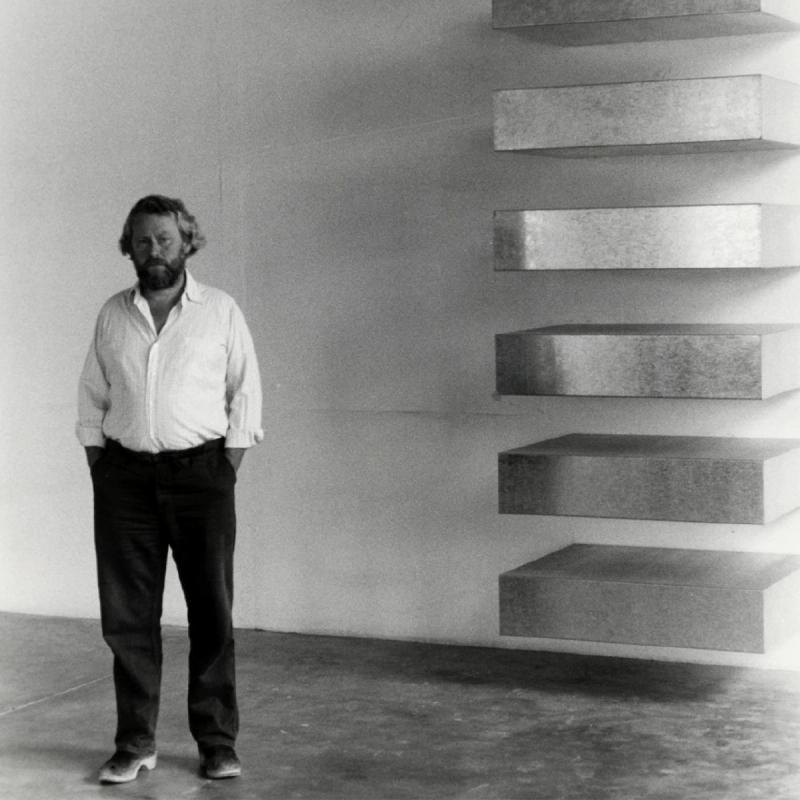Donald Judd
“My sculptures are reality itself and not an imitation of reality.”
A revolutionary figure of postwar art, Donald Judd (1928–1994) transformed the terms of modern painting and sculpture. His “object art” engaged industrial materials and processes, challenging notions of both categorical medium and originality. Judd conceived space as a constitutive element in his work, which typically comprised large, hollow geometric forms.
Born in Excelsior Springs, Missouri, Judd served in the United States Army Corps of Engineers in Korea (1946–47) before studying philosophy and art history at Columbia University and painting at the Art Students League in New York. The Panoras Gallery, New York, organized his first solo exhibition of abstract, landscape-based paintings in 1957, and from 1959 through 1965 he wrote art criticism for such publications as ARTnews and Arts. In the early 1960s, Judd began exploring three-dimensionality with wall reliefs and freestanding works. In 1963, he had a solo exhibition with Green Gallery, New York, and established a lifelong working relationship with sheet-metal fabricator Bernstein Brothers. His turn to industrial production—he outsourced the manufacture of his works in aluminum, brass, copper, galvanized iron, and stainless steel, thereby rejecting the importance of the artist’s hand and privileging the idea itself—was significant for an emerging generation of Conceptual artists. In 1965, he published his landmark essay
“Specific Objects,” which celebrated a new kind of artwork that eschewed categories of sculpture and painting and focused on “real space.” In the second half of the 1960s, Judd created many of his iconic forms, which include stacks, progressions, bull-nosed shapes, and boxes. For the next three decades, he iterated these forms in various metals, plywood, and colored Plexiglas.
Judd worked with Leo Castelli Gallery in New York from 1965 through 1985, when he left for Paula Cooper Gallery. In 1968, he purchased a five-story cast-iron building on Spring Street in New York, where he created permanent installations of his work alongside that of his peers. In 1973 he began acquiring properties and mounting installations in Marfa, Texas. He established the Judd Foundation in 1977 and the Chinati Foundation in 1986. His work was featured in the Venice Biennale (1980) and Documenta, Kassel (1968, 1977, 1982). Over the course of his career, his pursuits extended to the preservation and repurposing of existing buildings, furniture design, and printmaking, and he published writing that advocated for the role of artists and critical thought in society. Judd’s work has been the subject of numerous retrospectives internationally, including those organized by the Whitney Museum of American Art, New York (1968, 1988); Stedelijk Van Abbemuseum, Eindhoven (1970, 1987); Pasadena Art Museum (1971); National Gallery of Canada, Ottowa (1975); Kunstmuseum Basel (1976); Shizuoka Prefectural Museum of Art, Japan (1992); Museum Boymans-van-Beuningen, Rotterdam (1993); Museum Wiesbaden, Germany (1993); Tate Modern, London (2004); and Museum of Modern Art, New York (2020).
Selected Artworks
- Donald Judd
- Untitled (92-9 Ballantine), 1992
- Douglas fir plywood sand-painted cadmium red light, with steel found object (barrel strap)
- 46½ × 46½ inches (118.1 × 118.1 cm)
- Donald Judd
- Untitled, 1989
- Douglas fir plywood
- Untitled (DSS 234), 1970
- Donald Judd
- Untitled (DSS 41), 1963
- Light cadmium red oil on wood
- 19½ × 45 × 30½ inches (49.5 × 114.3 × 77.5 cm)
